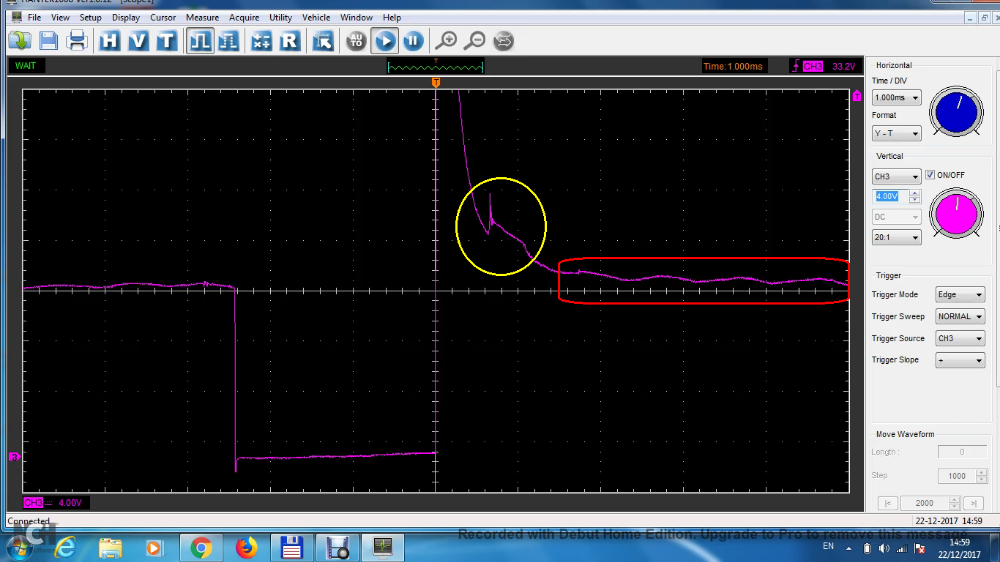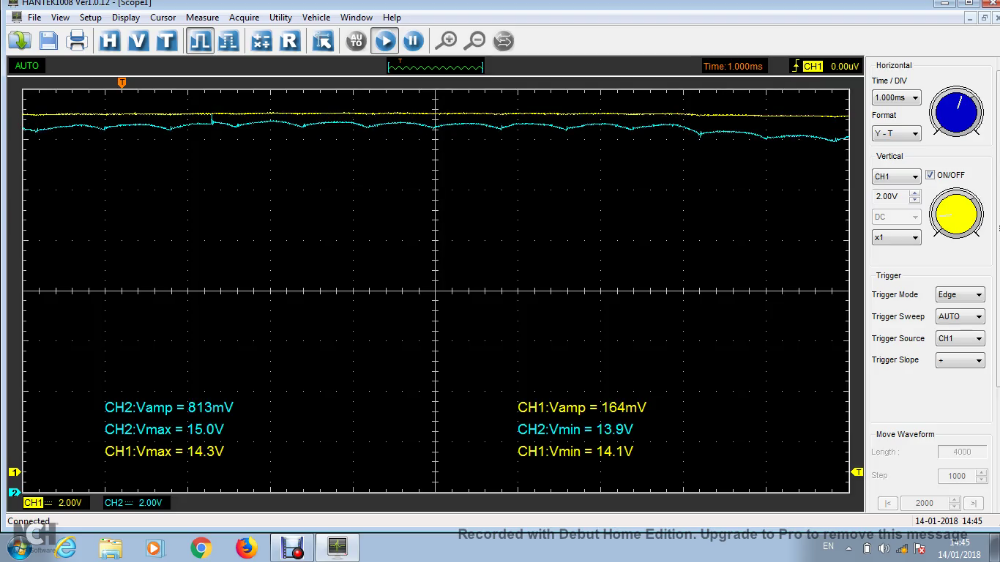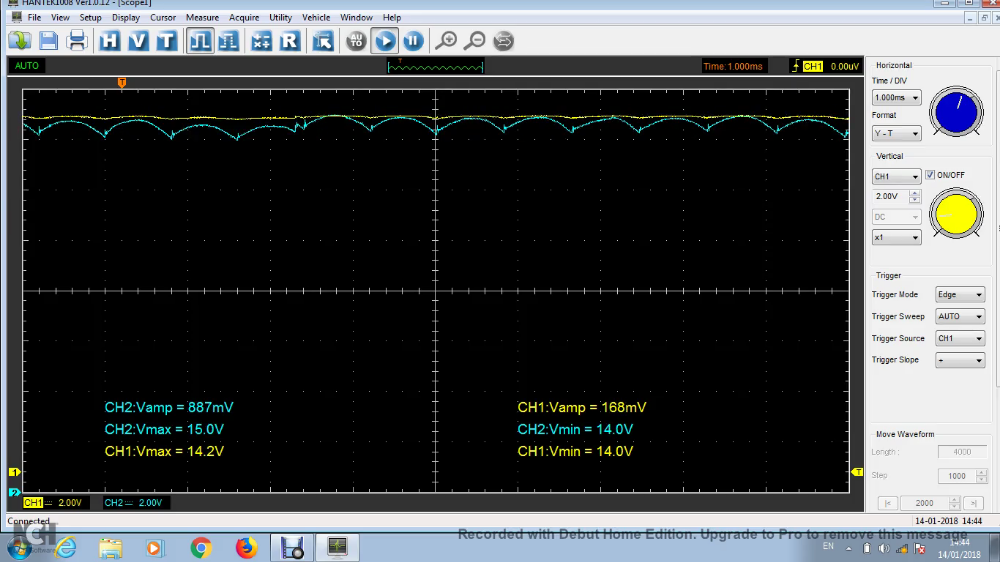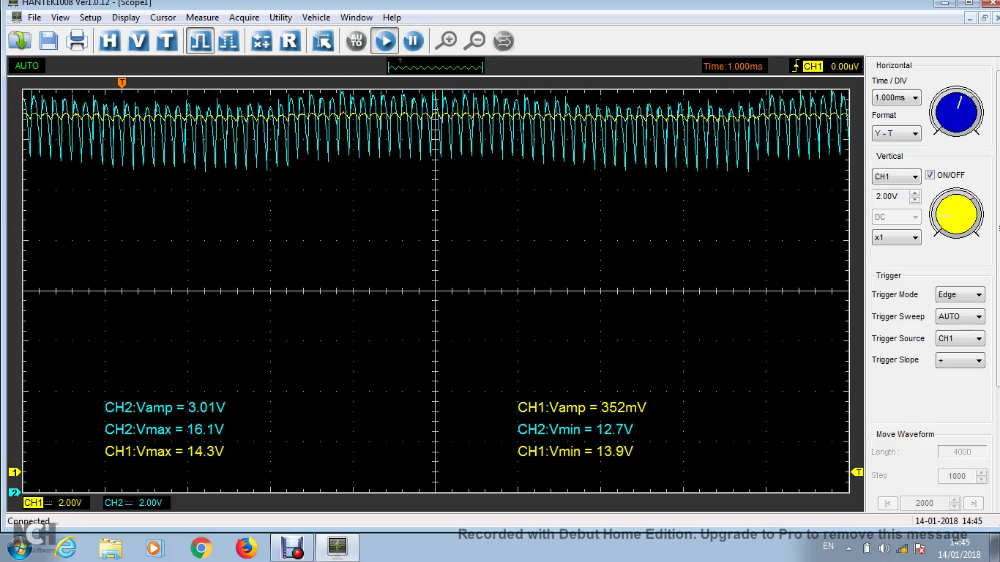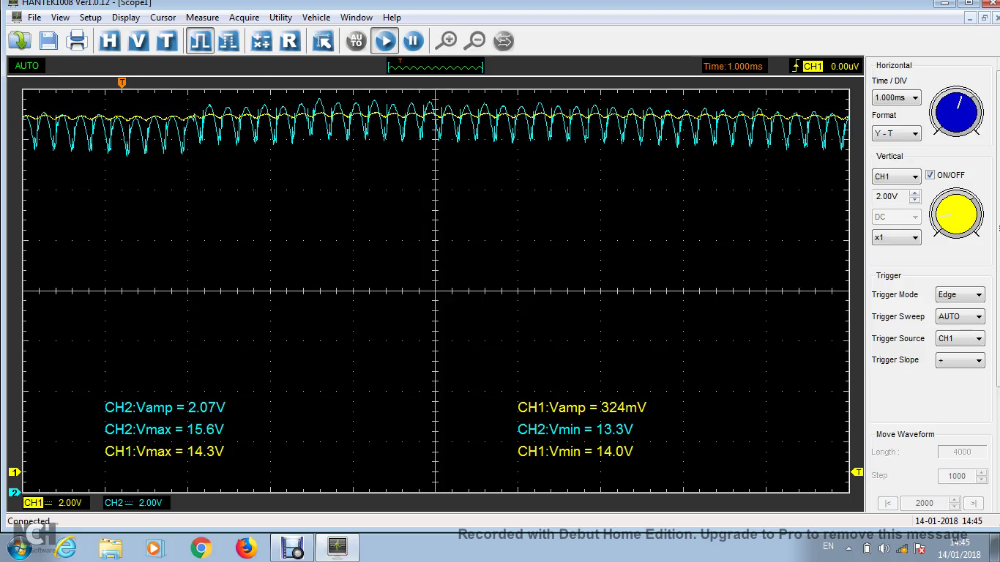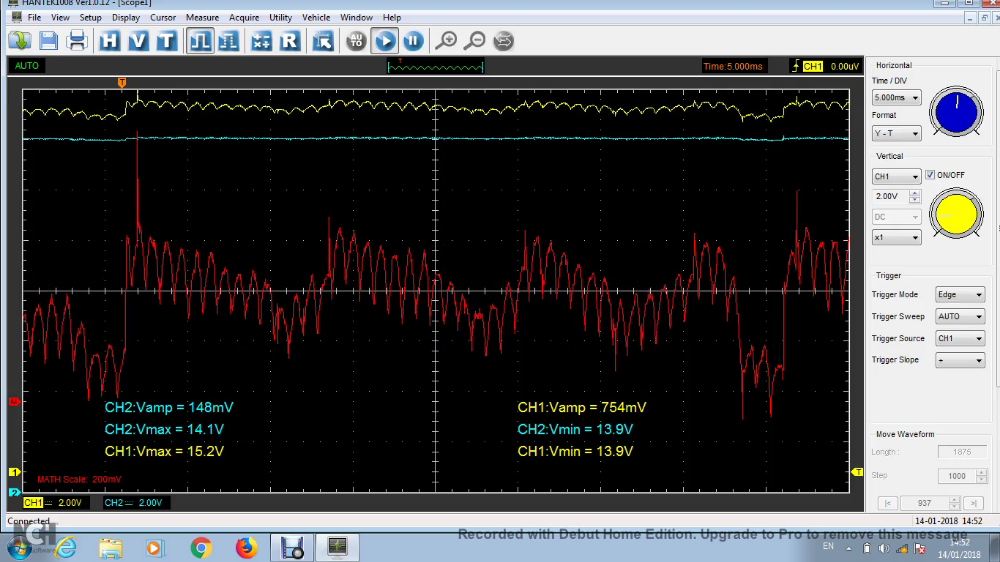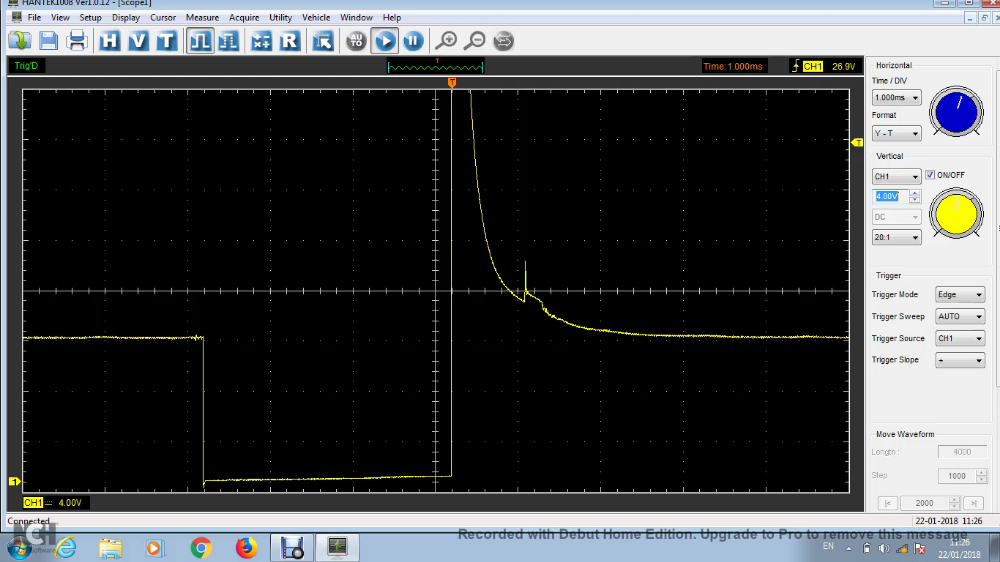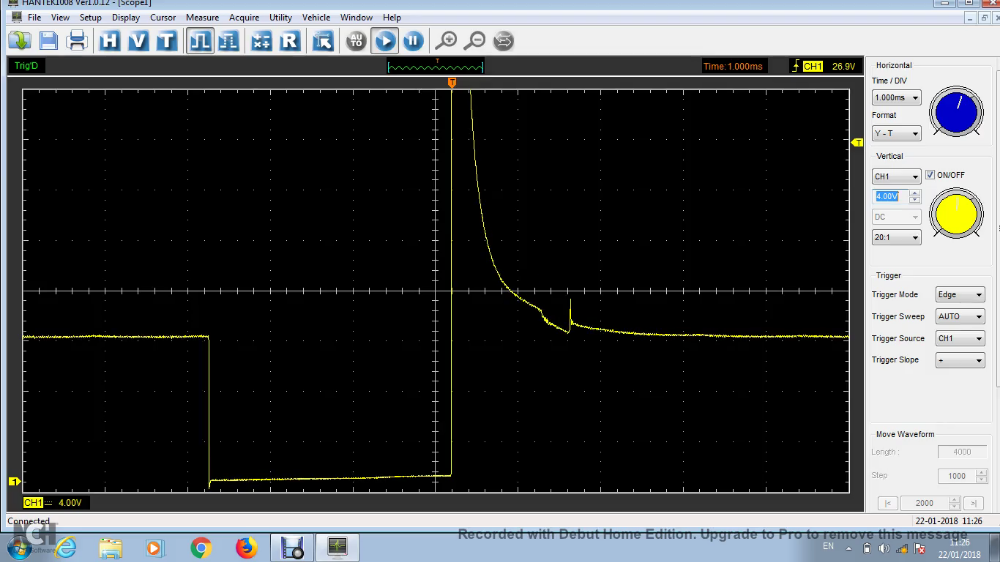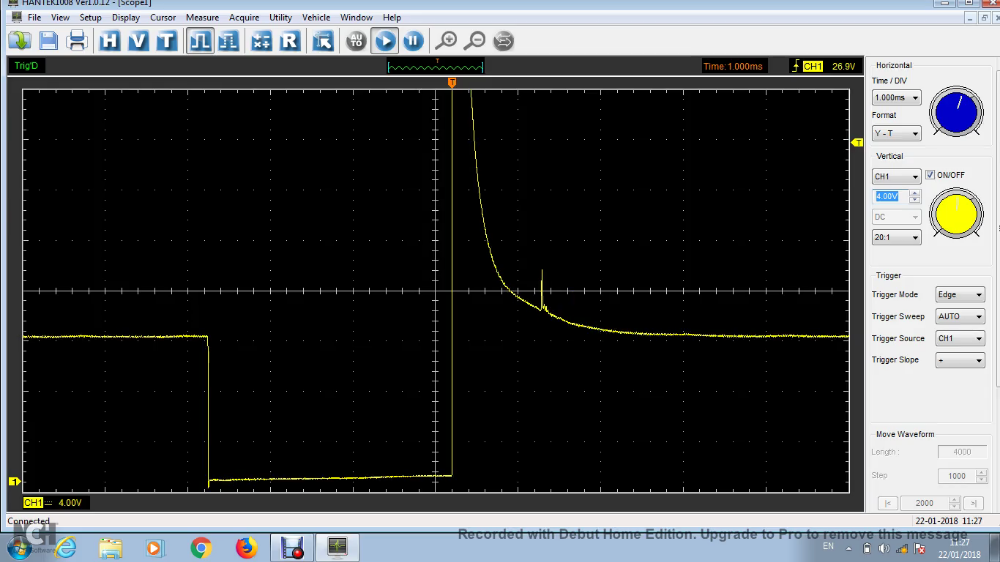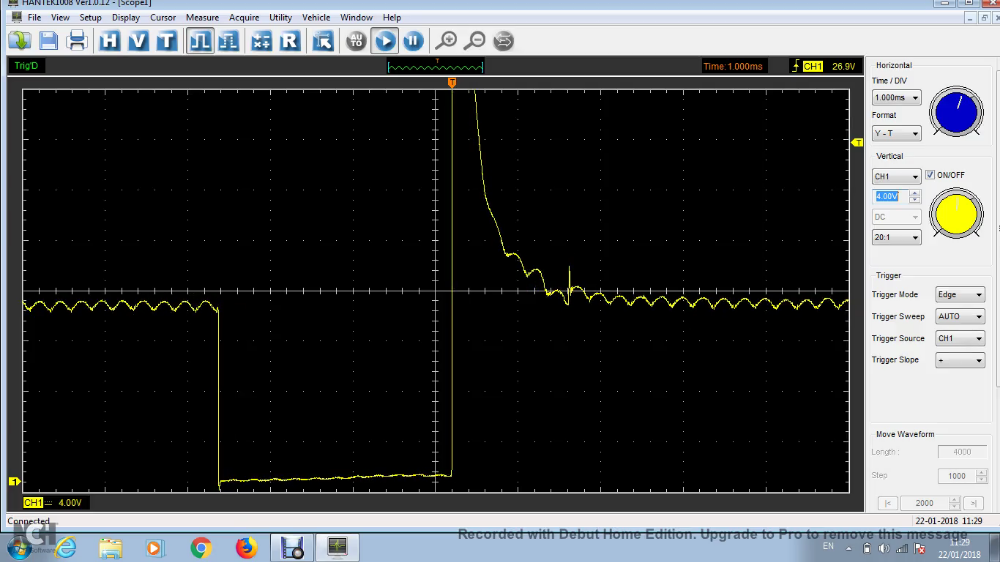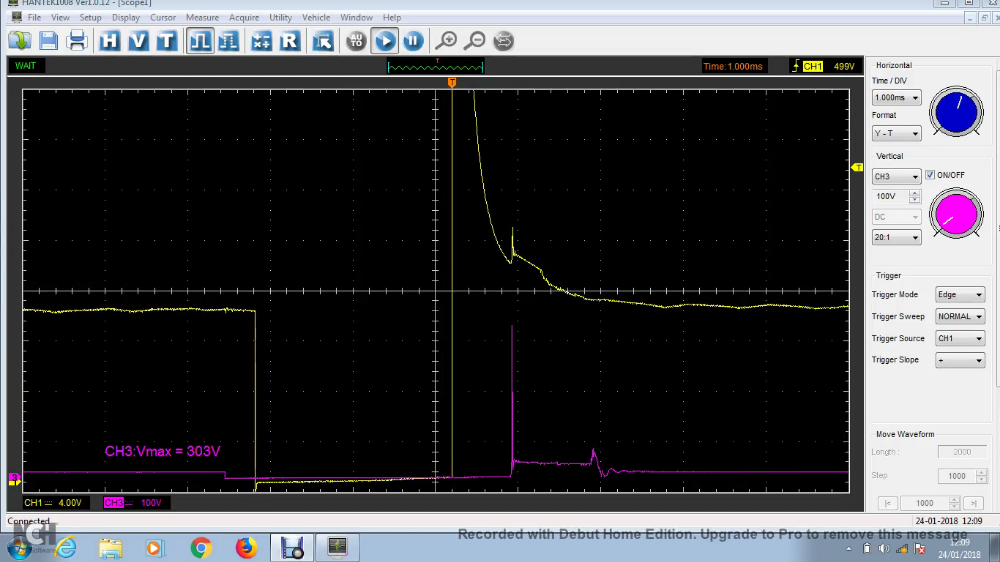*** Restricting New Posts to SD Premium Members ONLY *** (09 May 2025)
Just made a new account? Can't post? Click above.
Bad Alternator Diode causing transmission/speedometer problems
- SailorBob
-
 Topic Author
Topic Author
- Offline
- Elite Member
-

I was messing around with my 99 Nissan Almera ( Euro Sentra ) which is having some O2 and fuel efficiency issues and saw what looked like waves in the battery line of the injector waveforms:
I also circled what I think to be to the closing pintle hump.
The thing I had noticed is that the closing pintle hump seems to jump around and or disappear, but when the radiator fan comes on it stabilizes. All four injector display this behavior. Originally I though maybe they're all just dirty and intermittently sticking, but those waves also made me think maybe there is an AC ripple problem in the system.
So after watching Danner's alternator diode videos I decided to check out what was going on with my alternator. First I tried using the AC setting on two of my multimeters to measure the AC voltage, but they both just freaked out for some reason. Then I used a Solar BP9 to measure at the battery and it told me 150mv of AC at the battery. I also measured about 300mv voltage drop between the alternator and battery with no load.
Then I pulled out my 1008c and recorded data. For some reason it won't let me post a link.
These are 10ms screens, 2v / div. I set the scope to measure amplitude and think that will tell me the size of the AC wave.
You can see here at idle with no load, about 800mv at the alternator and 164 at the battery post:
Here is with the blower, brights, rear defrost and radio on. The scope is reporting almost the same numbers, but there is clearly much more AC coming out of the alternator. Not sure why that is.
When revving the engine to red line at about 6k rpms it shows about 3v AC at the alternator and 350mv at the battery post:
Just running the engine constantly at 3k rpms shows about 2v AC at the alternator and 324 at the battery:
I also did another capture using the math function to subtract the battery voltage from the alternator voltage since I don't have AC coupling on this scope. I set the math trace to 200mv. Since I'm also subtracting out the AC at the battery, it's amplitude is a smaller than it really is:
What interesting about this is I think those sharp jumps are when the pistons are firing. They're about 40ms apart which is about the time between piston firings at idle.
Do I have a question here? I guess it's if AC ripple could actually be showing up in the injector waveform and potentially affecting injector performance. Other than that I just thought all this might interest someone else just for discussions sake.
Please Log in or Create an account to join the conversation.
- SailorBob
-
 Topic Author
Topic Author
- Offline
- Elite Member
-

And the alternator capture here:
And the one with the calculate math trace here:
Please Log in or Create an account to join the conversation.
- arbez
-

- Offline
- Premium Member
-

- Posts: 150
- Thank you received: 53
Please Log in or Create an account to join the conversation.
- SailorBob
-
 Topic Author
Topic Author
- Offline
- Elite Member
-

Please Log in or Create an account to join the conversation.
- arbez
-

- Offline
- Premium Member
-

- Posts: 150
- Thank you received: 53
www.scannerdanner.com/forum/lab-scope-di...tek-1008c.html#16477
Would definitely be worth pursuing until you get a scope with better features.
Please Log in or Create an account to join the conversation.
- SailorBob
-
 Topic Author
Topic Author
- Offline
- Elite Member
-

The Solar BP9 showed 180mv AC ripple at the alternator. I measured 0.04v voltage drop between the alternator and battery at idle with no load.
On my capture Yellow trace is alternator 2v / div, blue is battery 2v / div, red is math function Y -B 200mv / div.
It shows start up on a 2 second rolling screen, then turn on brights, cabin blower full ( without AC ), radio and rear defrost. Then 200ms screen, then a 10ms screen, then 2k rpms for 30 seconds, then turn off the loads and go back up in reverse till the 2 sec rolling screen.
Off hand, the main things that stood out in this capture were that I saw way less difference between alternator and battery voltages, way less amplitude in the voltage at the alternator, but more difficulty in maintaining voltage levels at idle under load. That may be due to a general problem the car has with a low rough idle under load.
Just another interesting data point at the moment. If I have time later maybe I'll pull out and post some interesting screen shots.
Please Log in or Create an account to join the conversation.
- Juiced105
-
- Offline
- New Member
-

- Posts: 8
- Thank you received: 3
Please Log in or Create an account to join the conversation.
- arbez
-

- Offline
- Premium Member
-

- Posts: 150
- Thank you received: 53
Juiced105 wrote: This is what I plan on getting for my 1008c
www.aeswave.com/AC-Pass-Filter-Adapter-p9178.html
There you go Sailor Bob. Just what you need. Someone was thinking.
Please Log in or Create an account to join the conversation.
- Scannerfanner
-
- Offline
- Junior Member
-

- Posts: 30
- Thank you received: 7
Please Log in or Create an account to join the conversation.
- SailorBob
-
 Topic Author
Topic Author
- Offline
- Elite Member
-

Please Log in or Create an account to join the conversation.
- SailorBob
-
 Topic Author
Topic Author
- Offline
- Elite Member
-

Please Log in or Create an account to join the conversation.
- arbez
-

- Offline
- Premium Member
-

- Posts: 150
- Thank you received: 53
SailorBob wrote: Thanks, but I just ordered a box of capacitors of amazon and I'll just use that method since the whole 100 piece assortment of capacitors was the same price as that thing.
Let us know how that goes. Take some pictures & do a review afterwards. I'm still a little concerned that you could charge up the capacitor & maybe zap something, or someone.
For $17.00 with free shipping, that filter from AESWave seems like the perfect solution.
Please Log in or Create an account to join the conversation.
- Scannerfanner
-
- Offline
- Junior Member
-

- Posts: 30
- Thank you received: 7
SailorBob wrote: Which video / car are you referring to? The first one ( Nissan ) or the second one ( Mazda )?
universal testing methods video, pg 26 through 29. All about AC voltage corrupting signal to sensors, either from a battery charger or failed Alt. diodes.
Please Log in or Create an account to join the conversation.
- SailorBob
-
 Topic Author
Topic Author
- Offline
- Elite Member
-

In the meantime, here's another data point; a 2003 Nissan Primera 2L:
Please Log in or Create an account to join the conversation.
- Juiced105
-
- Offline
- New Member
-

- Posts: 8
- Thank you received: 3
Please Log in or Create an account to join the conversation.
- SailorBob
-
 Topic Author
Topic Author
- Offline
- Elite Member
-

Please Log in or Create an account to join the conversation.
- SailorBob
-
 Topic Author
Topic Author
- Offline
- Elite Member
-

Scannerfanner wrote: universal testing methods video, pg 26 through 29. All about AC voltage corrupting signal to sensors, either from a battery charger or failed Alt. diodes.
OK, so I unplugged the alternator and got some interesting results. When I first started looking at the injectors I thought the closing pintle hump was jumping around, but then after looking more closely I realized there was this voltage spike that was jumping around and sometimes hiding the pintle hump. As can be seen from these captures, sometimes the spike is before the hump:
sometimes after:
and some times exactly on top of it:
So I'm curious what this spike is and why it jumps around like that. It's like that on all four injectors. I haven't see this on the few other injectors I've looked at.
I also took another capture with the alternator plugged in, a bunch of accessories on, and revving the engine at 3000 rpm:
The AC from the alternator is really obvious here. I put up the video capture for anyone who's interested:
The big question is if this is actually a problem or not? And if it is exactly what the problem is? The diodes or the voltage regulator, or a weak old battery?
Please Log in or Create an account to join the conversation.
- SailorBob
-
 Topic Author
Topic Author
- Offline
- Elite Member
-

Please Log in or Create an account to join the conversation.

